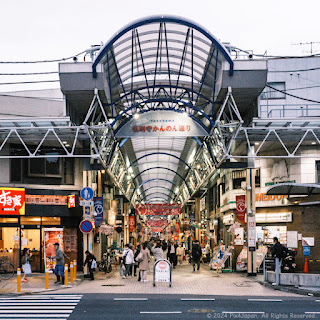Download a licensed digital photo: pix4japan.picfair.com
Order a print: pix4japan.smugmug.com
Sip the Essence of Spring: Discovering Gumyoji Sakura Beer at Homareyashuho
Location: Gumyoji, Minami Ward, Yokohama, Japan
Timestamp: 17:16・2024/04/09
Fujifilm X100V with 5% diffusion filter
ISO 800 for 1/250 sec. at ƒ/2
Classic Negative film simulation
The Homareyashuho Wine & Liquor Shop, established in 1932, is renowned for its signature Gumyoji Sakura Beer. Brewed locally since 2010, this unfiltered beer derives its distinctive flavor from yeast sourced from cherry blossoms grown in the nearby Gumyoji Temple grounds. Known for its fruity and robust flavor, the Sakura Beer continues to captivate beer enthusiasts to this day.
As depicted in my photo, the shop's décor mirrors the vibrant ambiance of Japan's cherry blossom festivals, featuring pink displays and lantern shades that celebrate the famous Sakura Beer. These decorations, reminiscent of those found across Japan during the cherry blossom viewing season, contribute to the shop's quaint charm.
In addition to the Sakura Beer, the shop boasts a diverse selection of locally sourced sake, authentic shochu, and awamori. Visitors can indulge in a variety of flavors, all sourced directly from breweries spanning the breadth of Japan. The shop also offers unique non-alcoholic flavored cider drinks for other customers including children.
Whether you're a connoisseur or a casual enthusiast, a visit to Homareyashuho Wine & Liquor Shop promises a delightful experience steeped in Japanese tradition and flavor.
Glossary:
- 桜・sakura: This term typically refers to cherry blossoms (flowers) but can also refer to the actual cherry trees. In Japanese culture, sakura holds deep symbolic meaning, representing the beauty and transient nature of life.
- 酒・sake: This term can refer to all alcoholic drinks in general, but in the above context, it specifically refers to Japanese rice wine, which is brewed through a fermentation process using rice, water, yeast, and koji mold.
- 焼酎・shochu: Shochu is a Japanese liquor distilled from various ingredients such as sweet potatoes, barley, or rice. It typically has a higher alcohol content than sake and is enjoyed in various ways, including straight, on the rocks, or mixed with water or other beverages.
- 泡盛・awamori: Awamori is a type of shochu that is a specialty of Okinawa, a region in Japan. It is made from Thai-style indica rice and is aged in traditional clay pots. Awamori has a unique flavor profile and is often consumed as a straight drink or mixed with water or ice.
Sources:
- Google Maps: Homareyashuho Wine & Liquor Shop・ほまれや酒舗
- Yokohama Gumyoji Shopping Street Cooperative Association (Japanese)
- Homareyashuho Wine & Liquor Shop (Japanese)
- Homareyashuho Wine & Liquor Shop (Japanese)
- The Yokohama Standard: Homareyashuho Wine & Liquor Shop (Japanese)
- Town News: Homareyashuho Wine & Liquor Shop (Japanese)
Copyright Notice for All Images:
© 2011-2024 Pix4Japan. All rights reserved.
Unauthorized use for AI training is strictly prohibited.
Visit www.pix4japan.com for prints and licensed download options.

















